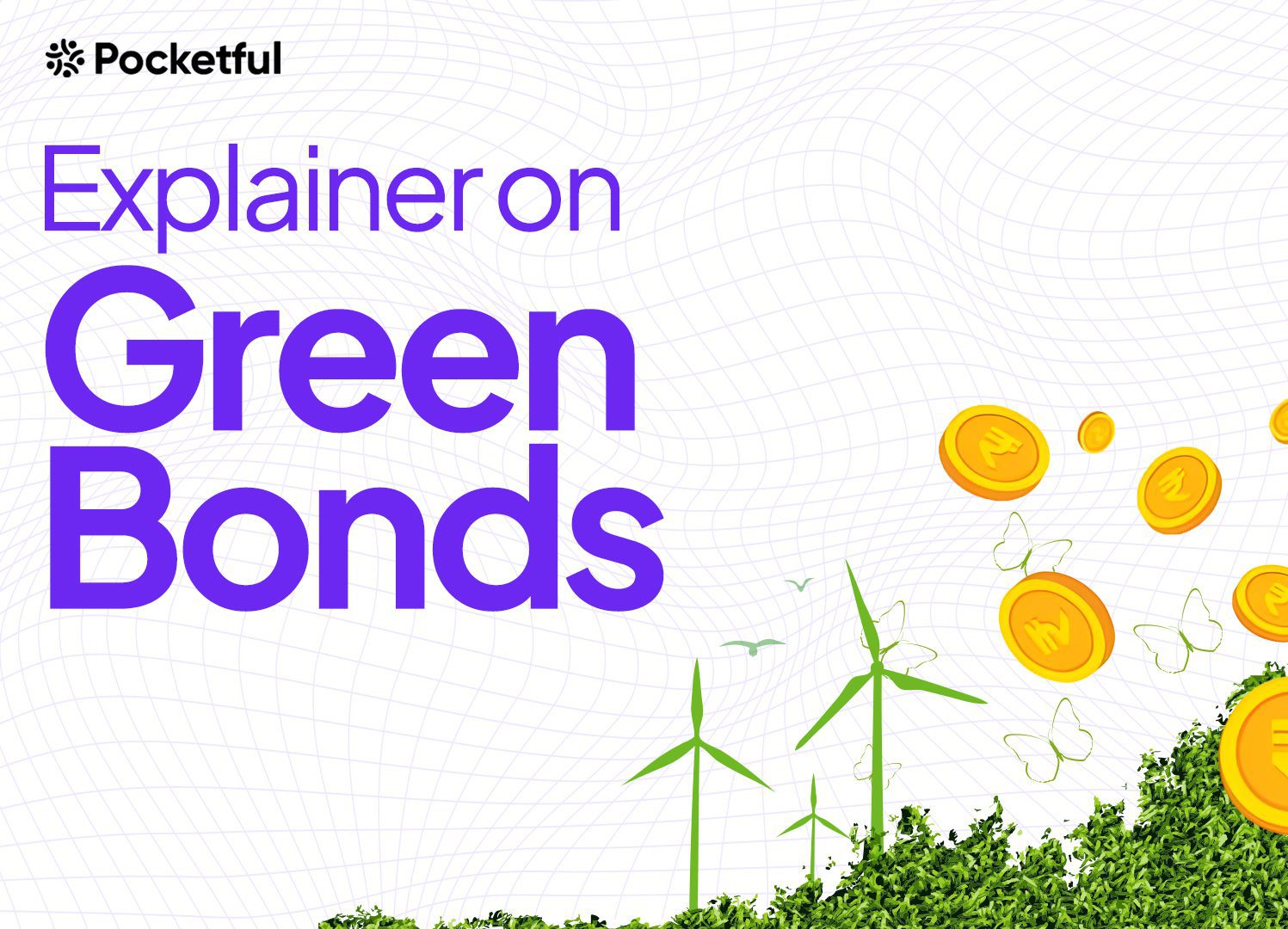| Type | Description | Contributor | Date |
|---|---|---|---|
| Post created | Pocketful Team | Mar-13-24 | |
| Optimize Formatting | Nisha | Feb-21-25 |

- Blog
- explainer on green bonds history process pros cons and future outlook
Explainer on Green Bonds: History, Process, Pros, Cons, and Future Outlook

Ever wondered how your investments can benefit both your wallet and the environment? That is the power of Green Bonds! These innovative financial instruments are shaking up the investing world, offering investors a chance to earn great returns while supporting sustainable projects that promote environmental well-being.
In our today’s blog, we will discuss green bonds – regular bonds with an eco-friendly twist.
Green Bonds Overview
Green bonds are a type of debt security used to finance projects with environmental benefits. These projects can include renewable energy, energy efficiency, clean water, sustainable agriculture and conservation. The government, corporations, and non-profit organisations issue these bonds. The average maturity is comparatively longer for green bonds, i.e., 17 years.
Did you Know?
The Swedish Environment Protection Agency issued the first-ever environmental bond in 1993.

Green Bonds History
It took decades for green bonds to evolve from a niche concept to a major sustainable finance topic.
The Story
In 2007, the Intergovernmental Panel for Climate Change, a UN agency, focused on providing scientific data about climate change and its economic implications.
A report was released that established the connection between human activities and global warming. This revelation, coupled with the rising frequency of natural disasters, provoked Swedish pension funds to ponder how they could leverage the funds that they managed to resolve the aforementioned problem.
Seeking guidance, they approached their bank, SEB (Skandinaviska Enskilda Banken AB). The bank then recognised the synergy and fostered a unique solution bridging the financial needs with environmental expertise. SEB then facilitated the connection between these financial endeavours and the World Bank and provided its extensive expertise in investing in environmental projects globally.
The solution was obvious in observation. But despite the World Bank’s promising environmental projects and proven issuance record of bonds, a critical question remained: how could investors gain absolute confidence that their contributions directly managed climate issues?
This sparked another collaboration with CICERO, the Centre for International Climate and Environmental Research – an interdisciplinary research centre for climate research in Oslo. CICERO scientists were leading experts on climate issues who could provide a sound and reliable view of whether a project would positively impact the environment.
In 2008, this initiative led to the discovery of the first ‘labelled green bond’ by the World Bank and catalyzed the entire green bond market.
Did you Know?
The global green bond market has surpassed the threshold of INR 134 trillion in cumulative issuance.

Green Bonds in India
To reduce the carbon intensity of the economy, the Union Budget 2022-23 announced the issue of green bonds.
The categories of green bonds include renewable energy, energy efficiency, sustainable management of natural resources, clean transportation, sustainable water, green building etc.
For the same, a framework known as Green Bond Principles was designed by the International Capital Market Association (ICMA).
The four core components as outlined by ICMA green bond principles are as follows
1. Use of Proceeds
The government of India will use the proceeds raised from Sovereign Green Bonds (SGrB) to finance and refinance expenditure either partially or wholly for eligible green projects and it will be made sure that proceeds get allocated to projects within 24 months after the issuance.
2. Project Evaluation and Selection
The Ministry of Finance has constituted a “Green Finance Working Committee” (GFWC) headed by the Chief Economic Advisor and GFWC. They will meet twice a year to support the Ministry of Finance with the selection and evaluation of projects. However, the initial evaluation of the project will be done by the concerned Ministry with the help of experts.
3. Management of Proceeds
The proceeds will be deposited to the Consolidated Fund of India (CFI) and then the funds from CFI will be withdrawn as and when needed for eligible green projects.
A separate account will also be created by the Ministry of Finance (GOI) to monitor the proceeds allocation and avoid any malpractice. Additionally, the Public Debt Management Cell (PDMC) will keep track of proceeds within the existing guidelines
4. Reporting
The Indian Government has pledged to offer investors transparent reporting about the allocation of the proceeds from green bonds and the environmental impact of projects funded.
Read Also: What are Bond Yields?
The Process of Issuance of Green Bonds
- The concerned Ministry will conduct an initial evaluation to identify the list of eligible green projects depending on the framework and submit it to GFWC.
- Members of the GFWC under the guidance of a climate specialist from Niti Aayog as well as the Representative from the Ministry of Environment, Forest and Climate Change, will evaluate and analyse the complete list of the submitted projects.
- Once the Finance Bill is passed, the Ministry of Finance will notify the Reserve Bank of India (RBI) about the amount of eligible green expenditures for which proceeds from green bonds can be used.

India’s First Green Bond
India issued the first tranche of its Sovereign Green Bonds worth INR 8000 crore on January 25, 2023, and the proceeds were used for green projects such as solar power, wind and small hydro projects and other public sector projects that help reduce the economy’s carbon footprint.
This offering was sold in 5-year and 10-year tenors through a uniform price auction on January 25, 2023. A similar offering was scheduled for February 9, 2023.
Also, driven by the shared goal of sustainable development, the World Bank Group and the Indian Government joined forces. The World Bank Sustainable Finance and ESG Advisory Services provided technical assistance and expertise to launch the sovereign green bond program, a key initiative to maximise finance for India’s climate transition and green growth.
Did You Know?
In 2015, Yes Bank, a private sector bank in India, successfully issued India’s first-ever green infrastructure bond, raising INR 1,000 crores.
Green Bonds Future Outlook
India has set an ambitious target of achieving net zero carbon emissions by 2070. Green Bonds are expected to play an essential role in mobilising the massive investments needed for this transition.
The Indian Government plans to issue more sovereign green bonds and encourage more involvement from private companies and municipalities.
Are green bonds good for long-term investing?
Green Bonds can be a good option for both long-term investing and ethical investing, but it depends on your individual goals and preferences.
Pros
- Green bonds can offer similar returns as traditional bonds, depending on the creditworthiness of the issuer and the conditions prevailing in the market. These bonds may even outperform conventional bonds in some situations.
- These bonds can diversify your portfolio, potentially spreading the risk and enhancing its resilience.
- By choosing green bonds, you can contribute to financing environment-friendly projects that best align with your values.
Cons
- The green bond market is relatively young in India, so long-term history data might be scarce.
- The bonds may have lower trading volumes compared to traditional bonds, which will impact the bond’s liquidity.
- The extremely long tenure of these bonds may make them undesirable.
Remember – Prioritizing ethical choices may affect your returns as compared to a purely profit-driven investment strategy.
Read Also: CAT Bonds: An Easy Explainer
Conclusion
To sum it up, whether green bonds are a good choice depends entirely on your financial goals, risk tolerance and ethical values. Analyse carefully what matters most and do proper research before investing because not all green bonds are perfect.
Frequently Asked Questions (FAQs)
What are green bonds?
Green bonds are a type of fixed-income security issued by the Government, municipalities, and corporations.
Why should I invest in green bonds?
You should invest in green bonds to make a positive impact, diversify your portfolio, and align your values with your investments.
Are green bonds risky?
Green bonds are riskier than traditional ones because of the limited availability of past data and lack of liquidity.
Are green bonds only for ethical investors?
No, anyone can invest in green bonds. But research well to ensure they meet your specific goals.
When was the first tranche of sovereign green bonds launched in India?
The first green bond in India was launched on January 25, 2023
Disclaimer
The securities, funds, and strategies discussed in this blog are provided for informational purposes only. They do not represent endorsements or recommendations. Investors should conduct their own research and seek professional advice before making any investment decisions.